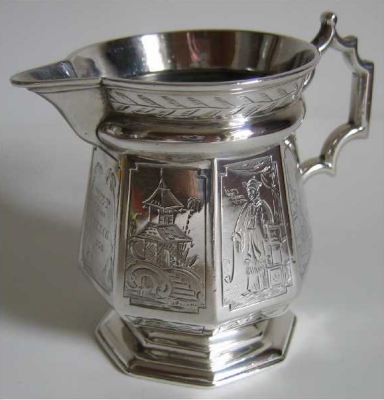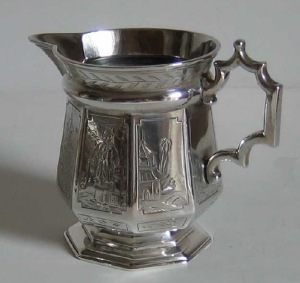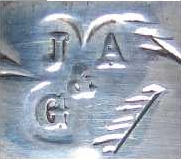(click on photos to enlarge the image)
AN UNUSUAL VICTORIAN CREAM JUG
This creamer was manufactured in London by John e George Angell,
belonging to an important silversmith family.
 |
Five hallmarks are impressed (as a group) on the body of
the creamer:
JA over GA (maker mark registered in 1844: the second A
is unreadable, as it was probably rubbed engraving the
cream jug after its hallmarking);
lion passant (sterling standard for silver, 925 ppt);
leopard head (Assay Office mark for London);
an old English capital letter L (date letter for
1846/1847);
Queen Victoria head (duty mark).
|
milk jug, London 1846, John e George Angell
|
The creamer has octagonal shape, a seven scrolls handle
of oriental inspiration and is fully engraved with 'chinoiseries'
decorations (uncommon in this period).
This style of decoration was in fashion in the
Netherlands and in England in the last quarter of the
17th century, following the import of oriental pottery
and porcelains and the publication of Far East
traveller's reports .
After its original fashion in the 17th century (mainly
on tea related hollowware, like tea caddies) , a revival
occurred in the 19th century (circa 1870) in connection
with the diffusion of the Aesthetic Movement.
|
 |
|
height: 9,5 cm; max width: 13 cm;
body width 6,5 cm; weight: 151 g
|
Five faces of the creamer are engraved
with palms, pagodas, floral motifs and oriental figures in their
everyday life; one face is engraved with floral motifs only and
one with a brief inscription (MEP da MEECG, 1870), denoting that
the creamer was used for a gift 22 years after its
manufacturing.
The influence of the rococo revival
fashion, affecting the decoration of many silverware
manufactured during the whole 19th century, may be found in many
details of the decoration, such as the scroll motif of the
stairs and the singular palm motif cartridge incorporating the
inscription
The creamer is fully hand made using the 'sewing
technique', with the body (obtained by working a flat sheet of
silver) soldered to the base.
 |
 |
John and George Angell hallmark
|
London 1846 hallmarks
|
|
 ASSOCIATION OF SMALL COLLECTORS OF ANTIQUE SILVER
ASSOCIATION OF SMALL COLLECTORS OF ANTIQUE SILVER ASSOCIATION OF SMALL COLLECTORS OF ANTIQUE SILVER
ASSOCIATION OF SMALL COLLECTORS OF ANTIQUE SILVER